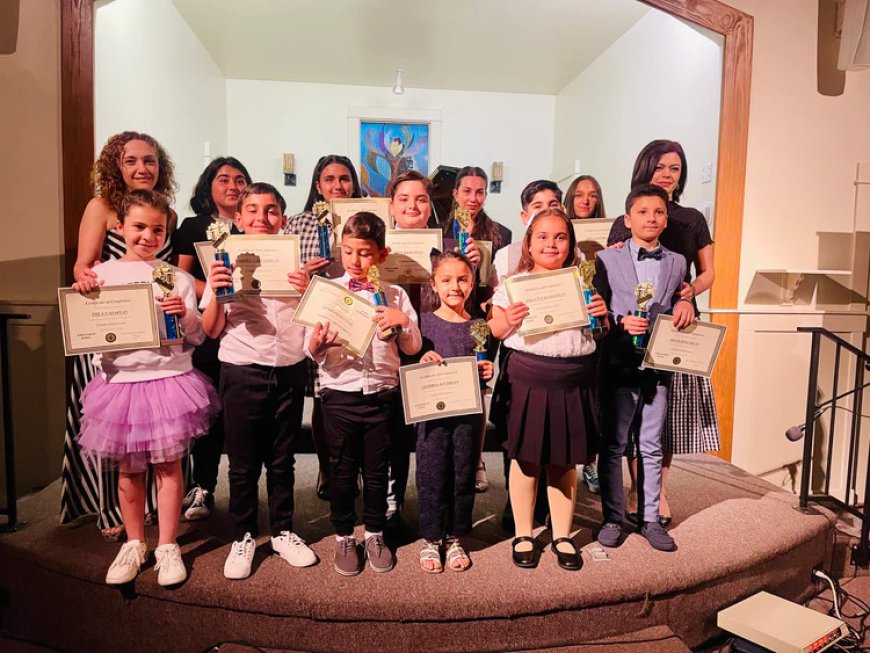Legacy of Commitment Hermine Shahbazyan's Revolutionizing Teaching and Music Therapy Approach
Discover Hermine Shahbazyan's teaching and music therapy methods, merging tradition and technology to inspire learners worldwide.

Having taught over 25 years, Hermine Shahbazyan's teaching philosophy stands out as unique and collaborative. Incorporating principles honed over centuries within modern pedagogical techniques. Her goal is to help students become confident, resilient learners with an enduring love for learning. Shahbazyan's passion for serving the needs of her students placed her at the forefront of current education philosophies. Thereby inspiring learners and educators to address various learning needs.
A Philosophy Borne of Empowerment
Shahbazyan is built around teaching complicated tasks in manageable pieces, so students can have that small victory for boosted confidence. She tries to meet students where they are: everyone comes with different kinds of challenges and strengths. Therefore, crafting individualized learning pathways expands academic growth while giving them the tools to adapt, think critically, and build self-confidence.
In recognition for her innovative input as an international educator. Shahbazyan has conducted master classes across Europe and the United States, sharing teaching techniques that are effective. Students have indeed done well academically as well as personally through her guidance. Many continue to participate in educational competitions and even receive attention for their accomplishments.
Advocate for Accessible Education
Shahbazyan is an ardent believer in accessibility for education. She feels that every student deserves an opportunity to explore her/his potential in a supportive, nonjudgmental environment. The teaching strategies that she favors are based on self-expression, acceptance, and emotional resilience—qualities that have found lasting impact in her students and peers. As a mentor, lecturer, and speaker, she has inspired educators to include diversity and adaptability in their approaches.
Using Technology to Reach More Children
She has placed the power of digital tools in the online environment into her teaching to enable quality education to reach learners anywhere in the world, at any time. Her innovative approach of adhering to tradition with technology presents her as a visionary educator and an icon of the potential change that education may bring.
The Healing Power of Music
Along with her contribution to traditional education, Shahbazyan has opened a revolutionary way in teaching piano to children with special needs, such as Autism and ADHD. She firmly believed that music is therapeutic, and since then, she developed methods that break through the conventions of teaching. Turning piano lessons into a powerful cognitive and emotional development medium.
Music as a Therapy
Shahbazyan emphasizes how piano lessons can enhance motor skills, auditory processing. And executive functions such as memory, attention, and problem solving. For children with autism, the structured, repetitive patterns in music reduce anxiety and improve sensory processing and emotional regulation. Piano lessons also encourage social interaction through structured activities that foster eye contact, shared attention, and non-verbal communication—skills often challenging for these children.
By introducing tools like imitation-based learning, visual aids, and positive reinforcement, Shahbazyan cultivates a lively and interactive learning process. Her methods have proven that music can be a door to increased cognitive and emotional growth. While helping children develop skills that extend beyond the keyboard.
A Global Educator Icon
Professor Shahbazyan's work as an internationally recognized piano and organ professor shows that music education has great potential for healing. Professor Shahbazyan believes that the piano should be the child's favorite instrument because it creates a perfect union between tactile clearness and sound clarity. The predictable structure of the piano ensures security, and it allows the child to feel a sense of achievement in both their musical and emotional development.
The Science Behind Music's Transformative Power
From over a century ago, scientific research focused on the deep impact of music on human cognition and emotion. The works of early psychologists, such as Carl Seashore, formed an initiation to the understanding of how the perception of music relates to cognitive functions. Later studies, such as Alfred Tomatis’s work on classical music’s effects on learning and Gordon Shaw and Frances Rauscher’s exploration of the “Mozart effect,” furthered this understanding, though the latter’s claims have been tempered by subsequent research.
Modern discoveries indicated that musical training increases brain plasticity. Especially in the regions involving auditory processing, motor activity, and sensorimotor integration. The learning of an instrument such as the piano activates several regions in the brain, resulting in better verbal memory, language skills, and executive functions, which include solving problems and working memory. There is an especially positive effect for children, because these developing brains respond greatly to the cognitive and emotive stimulation of music.
Music Education for Children with Autism
For children with Autism Spectrum Disorder (ASD), music education offers unique advantages. Structured musical activities provide a predictable and engaging environment that helps children develop motor skills, sensory processing, and emotional regulation. Group music lessons encourage social interaction, developing skills like turn-taking, eye contact, and shared attention.
Shahbazyan's teaching approach is especially great for children with autism. The piano is a clear instrument because of its auditory and visual feedback. The sense of touch and motor coordination while pressing keys creates a more rewarding experience. Her lessons are full of structure and creativity; thus, ensuring students attain valuable skills in the most favorable environment.
A Plan for Lifetime Development
Shahbazyan's innovative methods and dedication to accessibility transformed hundreds of thousands of lives. Her faith in the power of education and music as tools to create a healthy human being inspires the students and educators worldwide. She combined tradition and innovation for lifelong learning and expression; with this foundation, each student, no matter their abilities, could reach their fullest potential.
For more information about the work of Hermine Shahbazyan, visit us and see her blog for deeper insights into her journey of transformational teaching.

 jfrankline
jfrankline